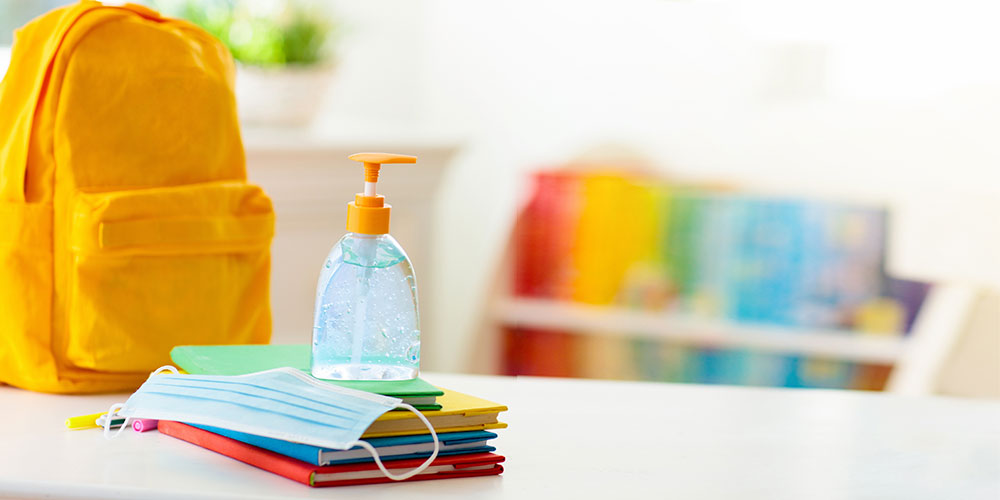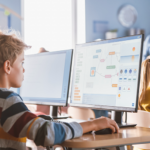I feel like a soldier who has to buy her own bullets, helmet, flak jacket, and air support before landing on the beach on D-Day.
Only, I’m not a soldier; I’m a public school teacher going into battle against COVID-19, and the beach is my own classroom, three weeks from now.
I don’t feel ready.
I’m a 20-year teaching veteran with a reputation for innovative, out-of-the-box thinking. My students tell me I’m a real-life Miss Frizzle from The Magic School Bus. I’m not afraid to be weird, make mistakes, admit failure, or laugh at myself when things go wrong. I’m also a super-planner: I had my remote learning plans ready March 11, days before the first statewide school closings. And I usually have four to five contingency plans for when things go wrong, because they often do.
For these reasons, many of my peers want to know what I am doing to prepare for COVID teaching this fall. An article from Christine McClure inspired me to make a plan and test my gear before students enter my classroom. Here are my conclusions and how I’m preparing for the upcoming school year.
The Strangest Back-to-School Gear List of My Career
Back-to-school always means a shopping trip or two, but this year’s school supply list is going to look entirely different.
Mandatory School Supplies:
- Masks that don’t climb up my chin and into my mouth as I talk
- Face shields that don’t fog up
- Voice amplifier so students can hear me through the masks (Here’s a video of me trying out three popular models.)
- Window fans for cross ventilation
- Disinfectant materials: Because these are hard to come by, I will likely use an inexpensive sanitizing solution of 4 teaspoons of bleach per 1 quart of water, per CDC guidelines for home sanitizing.
- A good desktop camera for recording lectures
- A laptop computer
- Lots of creative thinking
Optional Gear:
- A faux-hazmat shield pod: Initially, this might sound like a good idea, but what happens when a kid coughs inside the armpit hole and I’m stuck inside a COVID Bubble of Doom?
- Incontinence products: In the best of teaching times, bathroom breaks are a luxury you can’t count on, and these are the worst of times.
Course of Action: Keep Moist Droplets Outta Nose Holes!
Two of the biggest changes to teaching this year are social distancing and wearing masks. It’s our job as teachers not only to practice these precautions but to make sure our students do as well. The Center for Disease Control (CDC) explains why we should practice social distancing:
- COVID-19 spreads mainly among people who are in close contact (within about 6 feet) for a prolonged period.
- Spread happens when droplets from an infected person…land in the mouths or noses of people nearby.
- The droplets can also be inhaled into the lungs.
Personally, I don’t know anyone well enough to want their moist droplets landing in my nose holes, mouth, or lungs.
Masks are also imperative in battling COVID. In my state, the Department of Public Health and State Board of Education both require everyone to wear face coverings at all times in school buildings even when maintaining social distance. Masks are another line of defense to prevent someone else’s unwanted moist droplets from entering your nose holes.
As a teacher of teens and emerging adults, I find that a combination of grossness and humor works well to get your point across, especially for reticent learners who don’t like following the rules. And since no one likes the word “moist,” I will be using it repeatedly to help get my students not only to comply with mask wearing, but also to learn to love their masks.
I hope this combination of grossness and humor will make students more compliant, because social distancing, masks, and handwashing are the only weapons we currently have to fight this invisible enemy. And going to school without a mask is like entering battle without a helmet.
Teaching in a Mask: The Art of Breathing
Given the number of students and the physical size of many classrooms, few schools will be able to maintain social distance in classes, hallways, and buses. This means that masks—not social distance—will be the only thing keeping your child’s moist droplets out of other people’s nose holes.
However, teaching students while wearing a mask, face shield, and voice amplifier poses unique pedagogical challenges.
The first of which is just breathing.
I wear two masks and a face shield because that’s what nearly all interviewed medical professionals are wearing—and I trust they know something I don’t.
Unfortunately, I am very animated: I tend to gesture wildly, and I often sing and dance as I teach. That cannot happen in the COVID classroom. I can speak for about 10 minutes straight before I get winded and have to stop talking.
The best I can do (the best any of us can do) is practice: Practice wearing and speaking with a mask for 15, 30, and 60+ minutes at a time until we build up the stamina to teach like we need to. Soldiers don’t just imagine how they are going to engage in battle; they practice with their gear in the field repeatedly until bodily memory kicks in. We can’t just keep imagining a COVID classroom, because it will look, sound, and feel very different from a pre-COVID classroom.
Social-Distance Teaching: Safety Trumps Fun
The second issue is maintaining social distance.
To keep everyone safe, I will remain in a separate, marked-off teaching area in front of the class: at least 6 feet from the door and 6 feet from students’ desks.
Since breathing is a challenge and social distancing makes communication difficult, I will likely have to use a live flipped classroom model. That means I’ll pre-record myself teaching and then stand next to my own video like a creepy Vanna White, pointing and smiling at images of me on the screen while students watch.
After that, students will engage in some sort of passive seat work with their school-provided laptops while I watch at a distance. If students need help or have difficulties understanding the task, they will have to e-mail me from their seat on the other side of the room while I remain socially distanced in my teacher area.
This learning situation is less than ideal but necessary. In pre-COVID times, my classroom was full of group work, seminar discussions, theatrical reenactments, and hugs and high fives. I rarely lectured, and students rarely did “seat work.” My classroom always sounds like we are having a party—or at least it used to. It can’t sound like that anymore as it produces too many moist droplets, increasing COVID risk.
Learning has to be safe. And that means more passive learning in forward-facing, socially distanced rows while students remain physically separated from peers and teachers. Health departments recommend everyone move around as little as possible and disinfect anything anyone touches.
I think I will end each teaching day with a Silkwood decontamination shower and some very strong bourbon.
I Am Not a Soldier
The military uses a system called Intelligence Preparation of the Battlefield (IPB) to continuously analyze the environment for potential threats so they can make better tactical decisions. Here are the steps they follow:
- Define the battlefield environment.
- Describe the battlefield’s effects.
- Evaluate the threat.
- Determine the threat’s likely course of action.
I am not a soldier. I’m a public school teacher. But this year, I feel like my classroom has been defined as a battlefield, and I’ve had to evaluate the threat to myself and my students and prepare accordingly. I don’t want to get sick, and I don’t want to accidentally get my students sick, so this year, teaching and learning will have to look different than I’d like. But if we can be safe, make smart choices, and work together, maybe we can make this work to keep students learning.






